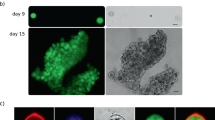Summary
A rapid and simple method for purifying second generation merozoites ofEimeria tenella was developed using a host tissue digestion fluid, containing 0.25% trypsin and 0.5% taurodeoxycholic acid, to liberate merozoites grown in chick embryos or from parasitized ceca. After filtration, the digestion procedure yielded 1.4×107 or 8.33×107 merozoites per embryo or cecum, respectively. These yields were nine-fold for embryos and three-fold for ceca in comparison to previous reports. Viability of the merozoites was normal as assessed by their ability to reinfect embryos and cell cultures. The new method has advantages in that large numbers of pure, viable merozoites can be obtained quickly and easily, and the procedures require minimal effort and supplies.
Similar content being viewed by others
References
Doran DJ (1974)Eimeria tenella: merozoites produced in cultured cells and attempts to obtain development of culture produced merozoites. Proc Helm Soc Wash 41:169–173
Elsner YY, Roberts WL, Shigenatsu A, Hammond DM (1974) Isolation of schizonts and merozoites ofEimeria callospermophili from cultured bovine intestinal cells. J Parasitol 60:531–532
Fernando MA, Al-Attar MA, Bowles GH (1984) Preparation of second generation merozoites ofEimeria necatrix free of host tissue. J Parasitol 70:154–155
Hollingdale MR, Kilejian A (1979) Purification ofPlasmodium lophurae exoerythrocytic merozoites by an ion exchange column. J Protozool 26:616–619
James S (1980) Isolation of second generation schizonts of avian coccidia and their use in biochemical investigations. Parasitology 80:301–312
Kouwenhoven NB, Kuil H (1976) Demonstration of circulating antibodies toEimeria tenella by the indirect immunofluorescent antibody test using sporozoite and second-stage schizonts as antigen. Vet Parasitol 2:283–292
Laxer MA, Healey MC, Youssef NN (1987) Production of monoclonal antibodies specific forEimeria tenella microgametocytes. J Parasitol 73:611–616
Long PL (1965) Development ofEimeria tenella in avian embryos. Nature 208:509–510
Mencher D, Pugatsch T, Wallach M (1989) Antigenic proteins ofEimeria maxima gametocytes: cell-free translation and detection with recovered chicken serum. Exp Parasitol 68:40–48
Mercado TI, Katusha K (1979) Isolation ofTrypanosoma cruzi from the blood of infected mice by column chromatography. Preparative Bioch 9:97–106
Patton WH (1965)Eimeria tenella: cultivation of the asexual stages in cultured animal cells. Science 150:767–769
Pugatsch T, Mencher D, Wallach M (1989)Eimeria maxima: Isolation of gametocytes and their immunogenicity in mice, rabbits and chickens. Exp Parasitol 68:127–134
Schmatz DM, Murray PK (1981)Trypanosoma cruzi: Selective isolation of pure trypomastigotes from cultured muscle cells. J Parasitol 67:517–521
Schmatz DM, Crane MSJ, Murray PK (1984) Purification ofEimeria sporozoites by DE-52 anion exchange chromatography. J Protozool 31:181–183
Stotish RL, Wang CC (1975) Preparation and purification of merozoites ofEimeria tenella. J Parasitol 61:700–703
Wagenbach GE (1969) Purification ofEimeria tenella sporozoites with glass bead columns. J Parasitol 55:833–836
Wagenbach GE, Challey JR, Burns WC (1966) A method for purifying coccidian oocysts employing clorox and sulfuric aciddichromate solution. J Parasitol 52:1222
Author information
Authors and Affiliations
Rights and permissions
About this article
Cite this article
Xie, M.Q., Gilbert, J.M., Fuller, A.L. et al. A new method for purification ofEimeria tenella merozoites. Parasitol Res 76, 566–569 (1990). https://doi.org/10.1007/BF00932562
Accepted:
Issue Date:
DOI: https://doi.org/10.1007/BF00932562




